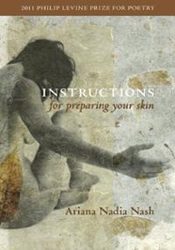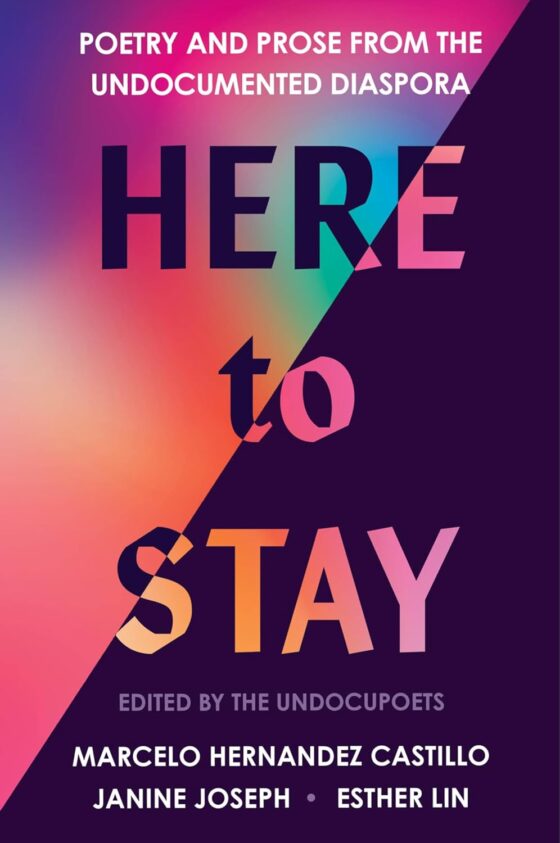
Winner of the 2011 Philip Levine Prize for Poetry, Instructions for Preparing Your Skin, Ariana Nadia Nash’s first full-length collection recalls Denise Duhamel’s early work, especially the smart, incisive sex of Smile and body-conscious critique in Kinky. Instructions for Preparing Your Skin takes a somber, deeply personal approach, dealing unabashedly with issues of embodiment, self-consciousness and -perception, with especial attention to the way a body will grind away at itself, chew fingernails to nubbins, or shrivel under the hot gaze of others. In response, Nash conjures polymelous gods of vengeful wrath, probes the caried, hard stuff of substance, tangible and somatic, arriving finally at a sharply polished satisfaction.
In the book’s most striking moments, Nash couples raw images with linguistic flexibility. In “Wallowing,” a word often accompanied in conversation by “in self-pity” or “in sadness,” Nash instead invokes the OED’s third entry, which denotes a rolling about, “relaxed in or upon some liquid…implying sensual enjoyment or indifference to defilement.” It’s this indifference Nash’s speaker embraces:
You ignored how
rough thick bristly
a pig’s skin is.
Maybe I roll in the mud
to cake it on, to carry
one more layer between the flesh
and the flies. (15)
This thickening, the spreading of psychic defense, manifests physically, in the dirt between surface and vermin. A similar impulse underlies the first half of “Calluses,” which likewise makes literal the old adage about “thick skin.” The ability to deflect criticism would seem especially relevant among the manifold voices impossible not to internalize, as a young person, in media-saturated, image-obsessed U.S. Here, that instinct undergoes an inversion, turned outward, aggressive:
Did I say I was gathering
myself back in? Did I lie
and say these ragged, bitten
stub-fingers make me strong?
Did I pretend muscle
is marble, claim
blood-raw sin is as
glossy as a photograph? (18)
 In these questions Nash sculpts a vicious culpability, borne of an introversion that can’t but double-back on itself, disoriented in the swirl of tender pinks and dark marrow, mottled as stone, brittle as burnt ossobuco. Ultimately, the solution is not whether to endure such pain or how, but to surrender to a “desire to command my pain,” she says, coping with the inevitable, recurrent shocks of second-guessing.
In these questions Nash sculpts a vicious culpability, borne of an introversion that can’t but double-back on itself, disoriented in the swirl of tender pinks and dark marrow, mottled as stone, brittle as burnt ossobuco. Ultimately, the solution is not whether to endure such pain or how, but to surrender to a “desire to command my pain,” she says, coping with the inevitable, recurrent shocks of second-guessing.
Indeed, many of Nash’s Instructions carry an edge of what Laurie MacDiarmid calls a “sensual cynicism,” referring to the anti-romantic Romanticism of Louise Glück’s “Mock Orange,” in which the speaker shuns conventional symbols of rosy optimism, yet yearns still for something like, if not quite, intimate human connection. In “The Orange,” Nash echoes this Glückean urge to subvert the status quo:
He hands me an orange, wants me
to taste: the sweet acid, the hundred ripe
juice capsules, the acrid paste of the rind
still clinging in patches to its surface.
As I savor, he sermons: you must taste
everything once, feed your gaping raw-red
tunnel, each spongy coral-bud of your
palate wants a different shock to awe it. (26)
The speaker enjoys it so fully, she goes on to indulge further than her pontificating interlocutor had anticipated, stripping citrus flesh with her fingernails, rind filled to the quick, finishing with a flash of teeth and menacing manacling of fruit. The sheer gusto of her audacious edacity signals a shift in the book’s tenor, moving from delicacy to something like delight. Surely, by “Each Morning,” we’re given glimpses of what it must taste like to reclaim a hope for sensual satisfaction:
Tell me these questions are tomatoes
and they may be green and sour now
but they will ripen and taste tart
and romantic again like berries. (48)
Her Instructions may be most indicative of this swerve from discomfiting consciousness nearer to comfortable inhabitance. And throughout, Nash adopts variform source material for poetic expression. From a meditative interpretation of Berlioz’s “Symphonie Fantastique,” to letters addressed to the Biblical Samson from his lover Delilah, to passages that depict in Technicolor Jaipur’s Peacock Gate, Nash introduces herself as a talented composer of multifaceted, well-crafted lyrics.




